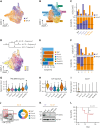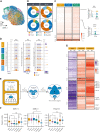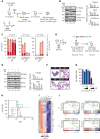Noncanonical EZH2 drives retinoic acid resistance of variant acute promyelocytic leukemias
- PMID: 35984905
- PMCID: PMC10653050
- DOI: 10.1182/blood.2022015668
Noncanonical EZH2 drives retinoic acid resistance of variant acute promyelocytic leukemias
Abstract
Cancer cell heterogeneity is a major driver of therapy resistance. To characterize resistant cells and their vulnerabilities, we studied the PLZF-RARA variant of acute promyelocytic leukemia, resistant to retinoic acid (RA), using single-cell multiomics. We uncovered transcriptional and chromatin heterogeneity in leukemia cells. We identified a subset of cells resistant to RA with proliferation, DNA replication, and repair signatures that depend on a fine-tuned E2F transcriptional network targeting the epigenetic regulator enhancer of zeste homolog 2 (EZH2). Epigenomic and functional analyses validated the driver role of EZH2 in RA resistance. Targeting pan-EZH2 activities (canonical/noncanonical) was necessary to eliminate leukemia relapse-initiating cells, which underlies a dependency of resistant cells on an EZH2 noncanonical activity and the necessity to degrade EZH2 to overcome resistance. Our study provides critical insights into the mechanisms of RA resistance that allow us to eliminate treatment-resistant leukemia cells by targeting EZH2, thus highlighting a potential targeted therapy approach. Beyond RA resistance and acute promyelocytic leukemia context, our study also demonstrates the power of single-cell multiomics to identify, characterize, and clear therapy-resistant cells.
© 2022 by The American Society of Hematology. Licensed under Creative Commons Attribution-NonCommercial-NoDerivatives 4.0 International (CC BY-NC-ND 4.0), permitting only noncommercial, nonderivative use with attribution. All other rights reserved.
Conflict of interest statement
Conflict-of-interest disclosure: The authors declare no competing financial interests.
Figures






Comment in
-
APL: Nemo finds its sea anemone.Blood. 2022 Dec 1;140(22):2311-2312. doi: 10.1182/blood.2022018020. Blood. 2022. PMID: 36454593 No abstract available.
Similar articles
-
Predictive modelling of acute Promyelocytic leukaemia resistance to retinoic acid therapy.Brief Bioinform. 2024 Nov 22;26(1):bbaf002. doi: 10.1093/bib/bbaf002. Brief Bioinform. 2024. PMID: 39807666 Free PMC article.
-
RARA and RARG gene downregulation associated with EZH2 mutation in acute promyelocytic-like morphology leukemia.Hum Pathol. 2018 Oct;80:82-86. doi: 10.1016/j.humpath.2018.02.023. Epub 2018 Mar 10. Hum Pathol. 2018. PMID: 29530751
-
Fusion proteins of the retinoic acid receptor-alpha recruit histone deacetylase in promyelocytic leukaemia.Nature. 1998 Feb 19;391(6669):815-8. doi: 10.1038/35901. Nature. 1998. PMID: 9486655
-
Novel treatment of acute promyelocytic leukemia: As₂O₃, retinoic acid and retinoid pharmacology.Curr Pharm Biotechnol. 2013;14(9):849-58. doi: 10.2174/1389201015666140113095812. Curr Pharm Biotechnol. 2013. PMID: 24433507 Review.
-
Retinoic acid regulatory pathways, chromosomal translocations, and acute promyelocytic leukemia.Genes Chromosomes Cancer. 1996 Mar;15(3):147-56. doi: 10.1002/(SICI)1098-2264(199603)15:3<147::AID-GCC1>3.0.CO;2-2. Genes Chromosomes Cancer. 1996. PMID: 8721678 Review.
Cited by
-
RBM39 Enhances Cholangiocarcinoma Growth Through EZH2-mediated WNT7B/β-catenin Pathway.Cell Mol Gastroenterol Hepatol. 2025;19(1):101404. doi: 10.1016/j.jcmgh.2024.101404. Epub 2024 Sep 14. Cell Mol Gastroenterol Hepatol. 2025. PMID: 39278404 Free PMC article.
-
An Acute Promyelocytic Leukemia Resistant to All-Trans Retinoic Acid: A Case Report of the ZBTB16::RARa Variant and Review of the Literature.Case Rep Oncol. 2023 Nov 23;16(1):1443-1450. doi: 10.1159/000534862. eCollection 2023 Jan-Dec. Case Rep Oncol. 2023. PMID: 38028572 Free PMC article.
-
Dual inhibition of EZH2 and G9A/GLP histone methyltransferases by HKMTI-1-005 promotes differentiation of acute myeloid leukemia cells.Front Cell Dev Biol. 2023 Mar 23;11:1076458. doi: 10.3389/fcell.2023.1076458. eCollection 2023. Front Cell Dev Biol. 2023. PMID: 37035245 Free PMC article.
-
Retinoids and EZH2 inhibitors cooperate to orchestrate anti-oncogenic effects on bladder cancer cells.Cancer Gene Ther. 2024 Apr;31(4):537-551. doi: 10.1038/s41417-024-00725-3. Epub 2024 Jan 17. Cancer Gene Ther. 2024. PMID: 38233533
-
Function of PML-RARA in Acute Promyelocytic Leukemia.Adv Exp Med Biol. 2024;1459:321-339. doi: 10.1007/978-3-031-62731-6_14. Adv Exp Med Biol. 2024. PMID: 39017850 Review.
References
-
- Di Croce L. Chromatin modifying activity of leukaemia associated fusion proteins. Hum Mol Genet. 2005;14(Spec No 1):R77–R84. - PubMed
-
- Grignani F, De Matteis S, Nervi C, et al. Fusion proteins of the retinoic acid receptor-alpha recruit histone deacetylase in promyelocytic leukaemia. Nature. 1998;391(6669):815–818. - PubMed
-
- Huang ME, Ye YC, Chen SR, et al. Use of all-trans retinoic acid in the treatment of acute promyelocytic leukemia. Blood. 1988;72(2):567–572. - PubMed
-
- de The H, Chen Z. Acute promyelocytic leukaemia: novel insights into the mechanisms of cure. Nat Rev Cancer. 2010;10(11):775–783. - PubMed
Publication types
MeSH terms
Substances
LinkOut - more resources
Full Text Sources

